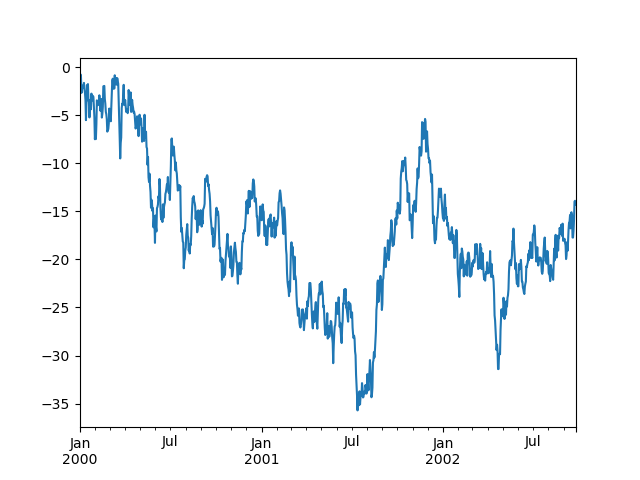reading-notes
https://faroukibrahim-fii.github.io/reading-notes/
10 minutes to pandas
Object creation
See the Data Structure Intro section.
Creating a Series by passing a list of values, letting pandas create a default integer index:
s = pd.Series([1, 3, 5, np.nan, 6, 8])
s
Out[4]:
0 1.0
1 3.0
2 5.0
3 NaN
4 6.0
5 8.0
dtype: float64
Viewing data
See the Basics section.
Here is how to view the top and bottom rows of the frame:
df.head()
Out[13]:
A B C D
2013-01-01 0.469112 -0.282863 -1.509059 -1.135632
2013-01-02 1.212112 -0.173215 0.119209 -1.044236
2013-01-03 -0.861849 -2.104569 -0.494929 1.071804
2013-01-04 0.721555 -0.706771 -1.039575 0.271860
2013-01-05 -0.424972 0.567020 0.276232 -1.087401
df.tail(3)
Out[14]:
A B C D
2013-01-04 0.721555 -0.706771 -1.039575 0.271860
2013-01-05 -0.424972 0.567020 0.276232 -1.087401
2013-01-06 -0.673690 0.113648 -1.478427 0.524988
Getting
Selecting a single column, which yields a Series, equivalent to df.A:
df["A"]
Out[23]:
2013-01-01 0.469112
2013-01-02 1.212112
2013-01-03 -0.861849
2013-01-04 0.721555
2013-01-05 -0.424972
2013-01-06 -0.673690
Freq: D, Name: A, dtype: float64
Selecting via [], which slices the rows.
df[0:3]
Out[24]:
A B C D
2013-01-01 0.469112 -0.282863 -1.509059 -1.135632
2013-01-02 1.212112 -0.173215 0.119209 -1.044236
2013-01-03 -0.861849 -2.104569 -0.494929 1.071804
df["20130102":"20130104"]
Out[25]:
A B C D
2013-01-02 1.212112 -0.173215 0.119209 -1.044236
2013-01-03 -0.861849 -2.104569 -0.494929 1.071804
2013-01-04 0.721555 -0.706771 -1.039575 0.271860
Selection by label
See more in Selection by Label.
For getting a cross section using a label:
df.loc[dates[0]]
Out[26]:
A 0.469112
B -0.282863
C -1.509059
D -1.135632
Name: 2013-01-01 00:00:00, dtype: float64
Selecting on a multi-axis by label:
df.loc[:, ["A", "B"]]
Out[27]:
A B
2013-01-01 0.469112 -0.282863
2013-01-02 1.212112 -0.173215
2013-01-03 -0.861849 -2.104569
2013-01-04 0.721555 -0.706771
2013-01-05 -0.424972 0.567020
2013-01-06 -0.673690 0.113648
Selection by position
See more in Selection by Position.
Select via the position of the passed integers:
df.iloc[3]
Out[32]:
A 0.721555
B -0.706771
C -1.039575
D 0.271860
Name: 2013-01-04 00:00:00, dtype: float64
By integer slices, acting similar to NumPy/Python:
df.iloc[3:5, 0:2]
Out[33]:
A B
2013-01-04 0.721555 -0.706771
2013-01-05 -0.424972 0.567020
Boolean indexing
Using a single column’s values to select data.
df[df["A"] > 0]
Out[39]:
A B C D
2013-01-01 0.469112 -0.282863 -1.509059 -1.135632
2013-01-02 1.212112 -0.173215 0.119209 -1.044236
2013-01-04 0.721555 -0.706771 -1.039575 0.271860
Selecting values from a DataFrame where a boolean condition is met.
df[df > 0]
Out[40]:
A B C D
2013-01-01 0.469112 NaN NaN NaN
2013-01-02 1.212112 NaN 0.119209 NaN
2013-01-03 NaN NaN NaN 1.071804
2013-01-04 0.721555 NaN NaN 0.271860
2013-01-05 NaN 0.567020 0.276232 NaN
2013-01-06 NaN 0.113648 NaN 0.524988
Missing data
pandas primarily uses the value np.nan to represent missing data. It is by default not included in computations. See the Missing Data section.
Reindexing allows you to change/add/delete the index on a specified axis. This returns a copy of the data.
df1 = df.reindex(index=dates[0:4], columns=list(df.columns) + ["E"])
df1.loc[dates[0] : dates[1], "E"] = 1
df1
Out[57]:
A B C D F E
2013-01-01 0.000000 0.000000 -1.509059 5 NaN 1.0
2013-01-02 1.212112 -0.173215 0.119209 5 1.0 1.0
2013-01-03 -0.861849 -2.104569 -0.494929 5 2.0 NaN
2013-01-04 0.721555 -0.706771 -1.039575 5 3.0 NaN
To drop any rows that have missing data.
df1.dropna(how="any")
Out[58]:
A B C D F E
2013-01-02 1.212112 -0.173215 0.119209 5 1.0 1.0
Stack
tuples = list(
zip(
*[
["bar", "bar", "baz", "baz", "foo", "foo", "qux", "qux"],
["one", "two", "one", "two", "one", "two", "one", "two"],
]
)
)
index = pd.MultiIndex.from_tuples(tuples, names=["first", "second"])
df = pd.DataFrame(np.random.randn(8, 2), index=index, columns=["A", "B"])
df2 = df[:4]
df2
Out[95]:
A B
first second
bar one -0.727965 -0.589346
two 0.339969 -0.693205
baz one -0.339355 0.593616
two 0.884345 1.591431
The stack() method “compresses” a level in the DataFrame’s columns.
stacked = df2.stack()
stacked
Out[97]:
first second
bar one A -0.727965
B -0.589346
two A 0.339969
B -0.693205
baz one A -0.339355
B 0.593616
two A 0.884345
B 1.591431
dtype: float64
Pivot tables
See the section on Pivot Tables.
df = pd.DataFrame(
{
"A": ["one", "one", "two", "three"] * 3,
"B": ["A", "B", "C"] * 4,
"C": ["foo", "foo", "foo", "bar", "bar", "bar"] * 2,
"D": np.random.randn(12),
"E": np.random.randn(12),
}
)
df
Out[102]:
A B C D E
0 one A foo -1.202872 0.047609
1 one B foo -1.814470 -0.136473
2 two C foo 1.018601 -0.561757
3 three A bar -0.595447 -1.623033
4 one B bar 1.395433 0.029399
5 one C bar -0.392670 -0.542108
6 two A foo 0.007207 0.282696
7 three B foo 1.928123 -0.087302
8 one C foo -0.055224 -1.575170
9 one A bar 2.395985 1.771208
10 two B bar 1.552825 0.816482
11 three C bar 0.166599 1.100230
Plotting
See the Plotting docs.
We use the standard convention for referencing the matplotlib API:
import matplotlib.pyplot as plt
plt.close("all")
The close() method is used to close a figure window.
ts = pd.Series(np.random.randn(1000), index=pd.date_range("1/1/2000", periods=1000))
ts = ts.cumsum()
ts.plot();
